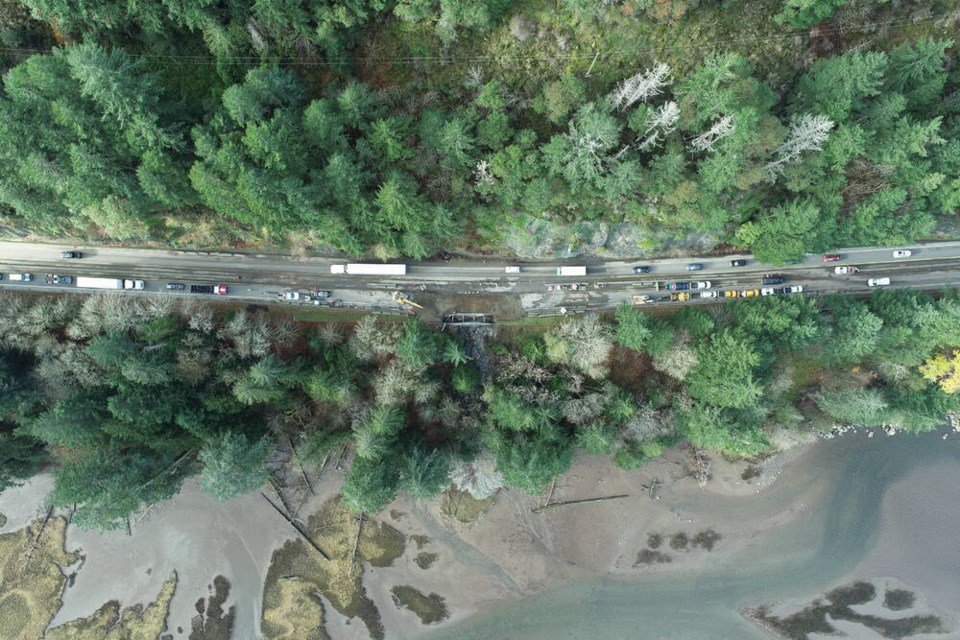The most basic principle of good planning is that individual, short-term decisions should help support long-term strategic goals. Can this concept be applied to Malahat Highway planning? We believe that it can.
This is a timely issue. The Malahat Highway is congested, dangerous and vulnerable to closures, as we experienced last week. There are many possible ways to address these problems. If we are smart, we will choose solutions that provide the most total benefits.
Expanding the Malahat or building a bypass or bridge across the Saanich Inlet can only provide temporary relief; within a few years the additional capacity will fill with induced travel, leading to more total congestion, crashes and pollution as more vehicles flood our roads. This contradicts other community goals.
We can do better. Instead of trying to move more vehicles, we can implement multimodal solutions that move more people, increasing efficiency and providing more total benefits.
British Columbia experienced multiple disasters caused by climate change this year, including extreme heat this spring, devastating wildfires this summer and recent fatal flooding caused by torrential rainstorms. These were all record-breaking but not unique — as the Earth continues to heat, such disasters are likely to increase in severity and frequency.
To help reduce these risks, British Columbia, the Capital Regional District and many local governments have declared climate emergencies and established ambitious emission-reduction targets. The province is also committed to supporting affordability, public health and rural economic development.
To achieve these goals, the CleanBC Roadmap establishes targets to reduce light vehicle travel by 25 per cent, and to approximately double walking, bicycling and public transit travel.
A multimodal solution starts with frequent and affordable bus transit, at least hourly frequency from Victoria to Nanaimo, with prices no higher than two local transit fares, plus pedestrian and bicycle improvements to access bus stops, and commute trip reduction programs to encourage travellers to choose public transit and carpools when possible.
Let’s put this into perspective. B.C. Transit currently operates 32 Route 61/65 buses from Sooke to Victoria each weekday, starting at 5:01 a.m. and ending after midnight, with $2.50 one-way fares or $85 for an unlimited-use monthly pass.
As a result of this frequent and affordable service, 22 per cent of Sooke morning-peak travellers used public transit, according to the CRD’s most recent travel survey.
In contrast, B.C. Transit only operates four Route 66 buses from Duncan to Victoria, leaving workdays from 5:32 a.m. to 6:25 a.m., with $10 one-way fares or $246 for a monthly pass. With such limited service and high prices, it is unsurprising that transit carries an insignificant portion of travellers on that corridor.
This is unfair and inefficient. Many residents north of the Malahat who cannot drive, cannot afford a car or are tired of driving would love to have frequent and affordable transit to Victoria. In addition to providing basic mobility to non-drivers, saving users money and reducing drivers’ stress, it would also help reduce congestion, crashes and pollution along the entire corridor. Everybody wins!
Bus service could also help in emergencies. Last week, the Malahat operated with just one lane that could only accommodate a few hundred vehicles per hour, but with frequent bus service could have carried many hundreds of people through the bottleneck.
Frequent and affordable bus service is far cheaper than any other proposed Malahat Highway improvement.
The 2020 South Island Transportation Strategy estimated that widening the Malahat Highway to four lanes would cost about a half-billion dollars, a new highway or rail service would cost about a billion dollars, and a Saanich Inlet bridge would cost $2 billion to $3 billion.
These projects would require many years to plan and complete, cause significant environmental damages, and increase future operating and maintenance costs. In contrast, frequent and affordable bus service could be operational in a few months and would cost less than the additional maintenance required for a new highway or bridge.
Highway widening only benefits motorists. Multimodal solutions benefit everybody, including non-drivers who enjoy more independent mobility, motorists who experience less congestion and crash risk, and rural communities that gain better access and more tourism.
Frequent and affordable bus service is not glamorous, but it certainly achieves the most goals, provides the greatest total benefits, and serves the largest number of travellers of all Malahat solutions.
For more information see Rethinking Malahat Solutions atvtpi.org/malahat.pdf.
Todd Litman is executive director of the Victoria Transport Policy Institute. Alastair Craighead is a former city councillor, CRD director and B.C. Transit board member, and current chair of the Friends of Rails to Trails Vancouver Island.



